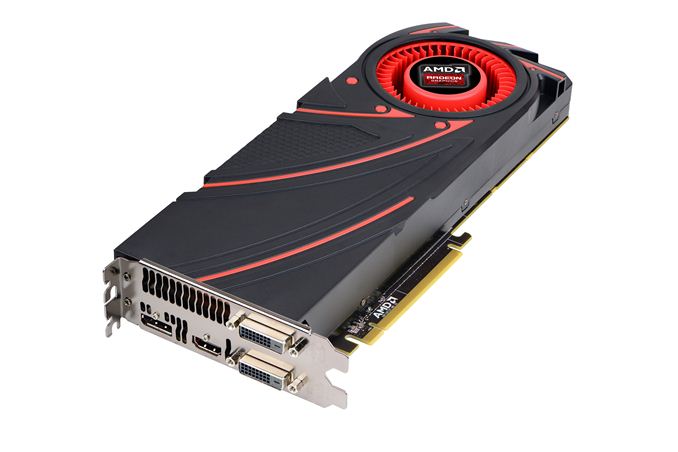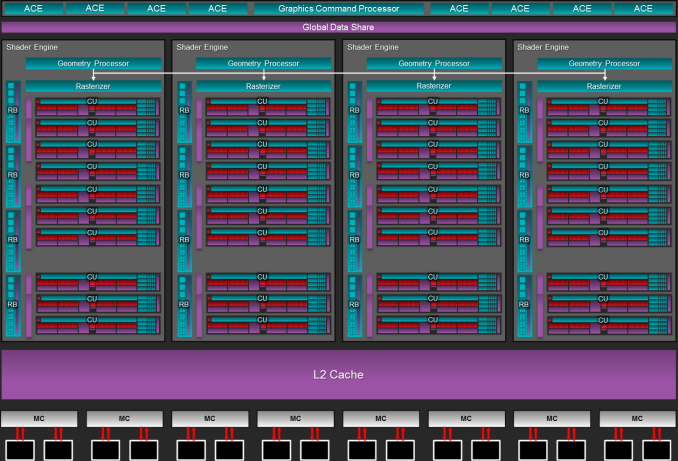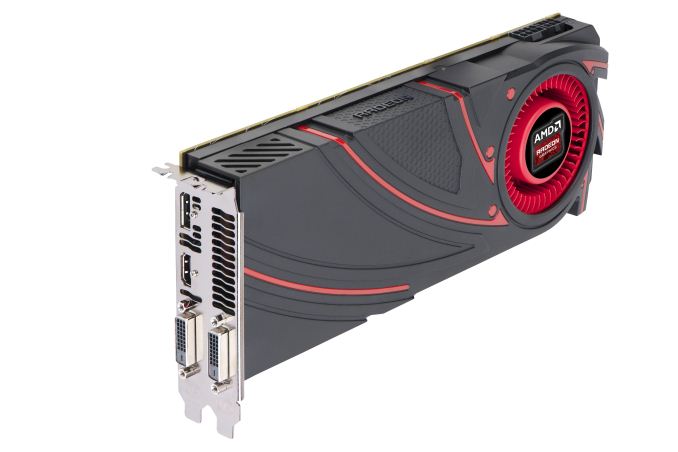The AMD Radeon R9 290 Review
by Ryan Smith on November 5, 2013 12:01 AM EST- Posted in
- GPUs
- AMD
- Radeon
- Hawaii
- Radeon 200

With the launch of AMD’s Radeon R9 290X less than 2 weeks ago, the video card marketplace has become very active very quickly. The 290X not only reasserted AMD’s right to fight for the video card performance crown, but in doing so it has triggered an avalanche of pricing and positioning changes that have affected both NVIDIA and AMD.
NVIDIA for their part cut the price of the GTX 780 and GTX 770 to $500 and $330 respectively, repositioning the cards and giving them their first official price cuts since their spring launches. Meanwhile AMD has also made some changes, and although 290X is unaffected for the moment, 290 was affected before it even launched, receiving an arguably significant specification adjustment. Consequently with GTX 780’s price cut being NVIDIA’s counter to 290X, 290 has gone from just being a lower tier Hawaii card to also being AMD’s counter-counter, and in the process has become a somewhat different card than what it was going to be just one week ago.
But before we get ahead of ourselves, let’s start at the beginning. With the successful launch of the 290X behind them, and the equally successful launch of their new flagship GPU Hawaii, AMD is ready to make their next move. Launching today will be the Radeon R9 290, the obligatory lower-tier part for AMD’s new flagship lineup. Making the usual tradeoffs for a lower-tier part, AMD is cutting down on both the number of functional units and the clockspeeds, the typical methods for die harvesting, in exchange for a lower price. Now officially AMD has not announced the Radeon R9 290 in advance, but with listings for it having already gone up on the same day as the 290X, it’s something that everyone has been expecting.
As always we’ll offer a full breakdown of performance and other attributes in the following pages, but before we even begin with that we want to point out that the 290 is going to be one of AMD’s most controversial and/or hotly debated launches in at least a couple of years. The merits of 290X were already hotly debated in some gaming circles for its noise relative to its performance and competition, and unfortunately 290 is going to be significantly worse in that respect. We’ll have a full rundown in the following pages, but in a nutshell AMD has thrown caution into the wind in the name of maximizing performance.
| AMD GPU Specification Comparison | ||||||
| AMD Radeon R9 290X | AMD Radeon R9 290 | AMD Radeon R9 280X | AMD Radeon HD 7970 | |||
| Stream Processors | 2816 | 2560 | 2048 | 2048 | ||
| Texture Units | 176 | 160 | 128 | 128 | ||
| ROPs | 64 | 64 | 32 | 32 | ||
| Core Clock | 727MHz | 662MHz | 850MHz | 925MHz | ||
| Boost Clock | 1000MHz | 947MHz | 1000MHz | N/A | ||
| Memory Clock | 5GHz GDDR5 | 5GHz GDDR5 | 6GHz GDDR5 | 5.5GHz GDDR5 | ||
| Memory Bus Width | 512-bit | 512-bit | 384-bit | 384-bit | ||
| VRAM | 4GB | 4GB | 3GB | 3GB | ||
| FP64 | 1/8 | 1/8 | 1/4 | 1/4 | ||
| TrueAudio | Y | Y | N | N | ||
| Transistor Count | 6.2B | 6.2B | 4.31B | 4.31B | ||
| Typical Board Power | ~300W (Unofficial) | ~300W (Unofficial) | 250W | 250W | ||
| Manufacturing Process | TSMC 28nm | TSMC 28nm | TSMC 28nm | TSMC 28nm | ||
| Architecture | GCN 1.1 | GCN 1.1 | GCN 1.0 | GCN 1.0 | ||
| GPU | Hawaii | Hawaii | Tahiti | Tahiti | ||
| Launch Date | 10/24/13 | 11/05/13 | 10/11/13 | 12/28/11 | ||
| Launch Price | $549 | $399 | $299 | $549 | ||
Diving right into the hardware specifications, Radeon R9 290 is a bit more powerful than usual for a lower-tier part. AMD has cut the number of CUs from 44 to 40 – disabling 1 CU per SE – while adjusting down the base GPU clockspeed and boost GPU clockspeed to from 727MHz and 1000MHz to 662MHz and 947MHz respectively. However AMD has not cut the amount of memory, the memory clockspeed, the memory bus width, or the number of ROPs, leaving those at 5GHz for the memory clockspeed, 512-bits for the memory bus width, and all 64 ROPs for the back-end hardware.
As a result the differences between the 290 and 290X are on paper limited entirely to the clockspeed differences and the reduced number of CUs. At their top boost bins this gives 290 95% the clockspeed of 290X, and 91% of the shader hardware, giving 290 100% of 290X’s memory performance, 95% of 290X’s ROP and geometry performance, and 86% of 290X’s shading/texturing performance.
Compared to AMD’s last generation offerings, the 290 is going to be closer to 290X than 7950 was to 7970. 290 retains a larger percentage of 290X’s shader and ROP performance, never mind the fact that the full 320GB/sec of memory bandwidth is being retained. As such despite the wider price difference this time around, performance on paper is going to be notably closer. Paper will of course be the key word here, as in the case of 290 more so than any other card we’ve looked at in recent history theory and practice will not line up. Compared to the 290X, practice will be favoring the 290 by far.
Moving on to power consumption, perhaps because of AMD’s more aggressive specifications for their lower-tier card this time around, power consumption is not dropping at all. AMD is still not throwing us any useful hard numbers, but based on our performance data we estimate the 290 to have a nearly identical TDP to the 290X, leading us to keep it at an unofficial 300W. Lower-tier parts typically trade performance for power consumption, but that will not be the case here. Power consumption will be identical while performance will be down, so efficiency will be slipping and 290 will have all the same power/cooling requirements as 290X.
Meanwhile like the 290X launch, the 290 launch is going to be a hard launch, and a full reference launch at that. As such we’ll be seeing 290 cards go up for sale at the usual retailers today, with all of those cards using AMD’s reference cooler and reference board, itself unchanged from the 290X.
As for pricing and competitive positioning, AMD will be launching the 290 at what we consider to be a very aggressive price of $399. Based on the initial specifications, the performance, and the competition, we had been expecting AMD to launch this at $449, mirroring the launch of the 7950 in the process. But AMD has gone one step further by significantly undercutting both themselves and NVIDIA.
290’s immediate competition on the AMD side will be the $549 290X above it and the $299 280X below it, while on the NVIDIA side the competition will be the $499 GTX 780 above it and the $329 GTX 770 below it. Pricing wise this puts 290 as closer competition to 280X/GTX 770 than it does the high-tier cards, but as we’ll see in our benchmarks AMD is aiming for the top with regards to performance, which will make price/performance comparisons both interesting and frustrating at the same time.
NVIDIA for their part will have their 3 game Holiday GeForce Bundle on the GTX 780 and GTX 770, presenting the same wildcard factor for overall value that we saw with the 290X launch. As always, the value of bundles are ultimately up to the buyer, especially in this case since we’re looking at a rather significant $100 price gap between the 290 and the GTX 780.
| Fall 2013 GPU Pricing Comparison | |||||
| AMD | Price | NVIDIA | |||
| Radeon R9 290X | $550 | ||||
| $500 | GeForce GTX 780 | ||||
| Radeon R9 290 | $400 | ||||
| $330 | GeForce GTX 770 | ||||
| Radeon R9 280X | $300 | ||||
| $250 | GeForce GTX 760 | ||||
| Radeon R9 270X | $200 | ||||
| $180 | GeForce GTX 660 | ||||
| $150 | GeForce GTX 650 Ti Boost | ||||
| Radeon R7 260X | $140 | ||||












295 Comments
View All Comments
doggghouse - Wednesday, November 6, 2013 - link
So at 60dB, it's as loud as someone talking next to you. In other words, you would have some difficulty hearing another person over the sound of the GPU fan. I would say that's pretty loud.I think the 290 and 290X have a lot of potential, but with the stock cooling I would stay away from it.
Vorl - Wednesday, November 6, 2013 - link
I don't remember the exact noise test, but I thought the measurement was taken right next to the card, at the fan... so if you put distance, and a case around the card, it will not be nearly as loud as that.ThomasS31 - Wednesday, November 6, 2013 - link
R9 290 series is the worst ever launch for AMD... this was a chance to show how professional they are and gain market share with a great opportunity and product... and they screwed it up and failed.And this is not he first time they failed to monetize their products. So maybe there shall be some personal consequences and changes needed.
Hope the new hires (leaders) change this and this is the last time we saw great products hindered with bad execution.
After the 7990 cooler I and what nVidia did they learned the lessons... but not.
And now as I hear they are not allowing custom coolers and/ or limit manufacturers in the use of the best coolers/design they could do... as competition is bad for market or what???
Mondozai - Friday, December 13, 2013 - link
lolmartixy - Wednesday, November 6, 2013 - link
So the takeaway is:There's a new king in town, and it's name is AMD.
For now...
+You get to be Mantle-proof.
What I wanna see now is Mantle on an nV card and g-sync on an AMD card.
nevertell - Wednesday, November 6, 2013 - link
Why is it so that when a ridiculously loud nvidia card gets released, people go crazy about the heat and noise generated, but when AMD does the same, they only focus on the performance?I do understand that the price and performance for these cards is pretty ground braking, but then again, AMD used to release some nasty adverts about people using Fermi cards. And fermi cards were not even this loud.
And considering the fact that the testbed here was probably properly ventilated and designed for hot and fast cards, I believe there is a significant portion of the market, who will buy the card and stick it into a small or badly ventilated or just crammed case and call it a day. And those people will not be able to get the performance advertised here, as their cards will probably throttle a lot more.
But I do love how the roles are switching, only 3 generations ago, AMD's and Nvidia's positions were exactly the opposite, at least in the power and noise, and mostly power efficiency, departments.
We still have to wait for 780ti, but seeing as titan is already having a run for it's money.
Death666Angel - Wednesday, November 6, 2013 - link
I don't care one bit about the loudness of a card. Anything I own has to be watercooled and the custom water cooling block costs the same whether it is from nVidia or AMD. So this card is a win on all fronts. And unless you have to buy reference design without switching to WC, I don't think you'll be disappointed.It's really hard to read 5 paragraphs on noise when that is the least of anyones concerns when buying a video card. People who are concerned with it have custom cooling stuff which is the same for most cards (nVidia or AMD), since most cards are the same. Or they don't care since their other stuff is louder and/or they use good headphones. So I think knocking the 290 for loudness is a bit petty. :)
Achaios - Wednesday, November 6, 2013 - link
Can't wait for Gigabyte's R9 290 SOC (Super Overclock) with 3X Windforce Cooler. I drool at the thought.ecuador - Wednesday, November 6, 2013 - link
Ryan, it is interesting to contrast this review to Anand's review of the FX 5800. You sound much more damning for a card that is much cheaper and faster than the competition at a 9.7dB louder, than Anand was for a card that was slower and 13dB louder than the competition back then! Ok, it is not for everyone until it gets custom coolers, but it sure gives you a lot for that tradeoff. The mystery is why AMD does not make a cooler that is worth a damn!swing848 - Wednesday, November 6, 2013 - link
Anand,Most people that read your reviews know you are a GeForce fan boy. And, the last page of your "review" tells people not to purchase the R9 290.
In fact, many people purchase this card BECAUSE THEY WANT IT. Let the buyer decide what he or she want in price and performance, and stop poking AMD in they eye with your GeForce stick. If anything give advice to people on how to keep temperatures under control with the least noise possible; but, no, you have to get on your GeForce box and pound AMD ... again. How much do they pay your or your company?
The R9 290 is a great card, and after reading several reviews, know it.